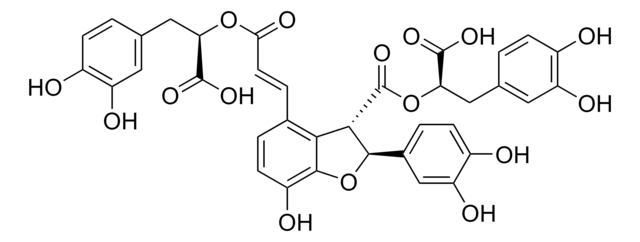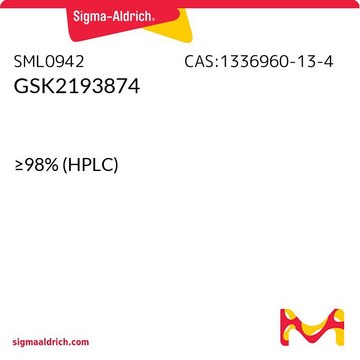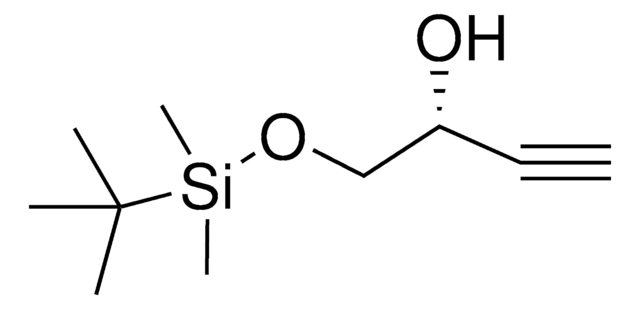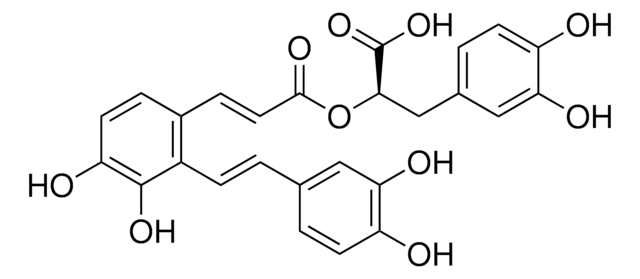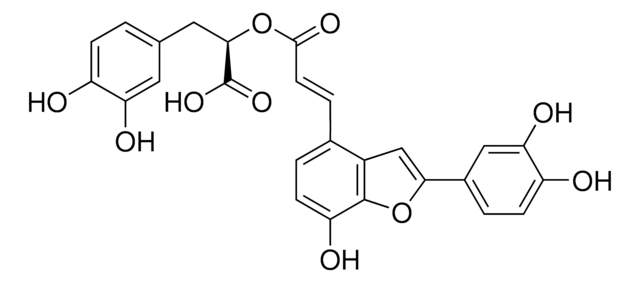추천 제품
생물학적 소스
plant
분석
≥85% (LC/MS-ELSD)
양식
solid
분자량
718.61
색상
light yellow to brown
solubility
water: soluble
응용 분야
metabolomics
vitamins, nutraceuticals, and natural products
저장 온도
−20°C
SMILES string
O1[C@H]([C@@H](c4c1c(ccc4\C=C\C(=O)O[C@H](Cc5cc(c(cc5)O)O)C(=O)O)O)C(=O)O[C@H](Cc3cc(c(cc3)O)O)C(=O)O)c2cc(c(cc2)O)O
InChI
1S/C36H30O16/c37-20-6-1-16(11-24(20)41)13-27(34(45)46)50-29(44)10-5-18-3-9-23(40)33-30(18)31(32(52-33)19-4-8-22(39)26(43)15-19)36(49)51-28(35(47)48)14-17-2-7-21(38)25(42)12-17/h1-12,15,27-28,31-32,37-43H,13-14H2,(H,45,46)(H,47,48)/b10-5+/t27-,28-,31-,32+/m1/s1
InChI key
SNKFFCBZYFGCQN-PDVBOLEISA-N
일반 설명
Salvianolic acid B, also known as Lithospermic acid B, is a polyphenol and a member of catechols. This bioactive natural compound is commonly found in plants such as Salvia Sp., Isodon rubescens, Mentha Sp., Canna indica, and Angelica keiskei. Existing research suggests that this plant-derived natural product possesses a range of biological properties, including anticancer, anti-inflammatory, hepatoprotective, cardioprotective and neuroprotective activities.
애플리케이션
It is a natural product derived from plant source that finds application in compound screening libraries, metabolomics, phytochemical, and pharmaceutical research.
생화학적/생리학적 작용
According to the existing research, Salvianolic acid B plays potential role in modulating inflammation, cell signaling, and immune responses by inhibiting the expression of COX, ERK, TNF-α, NO.
Salvianolic acid B has anti-obesity, antiviral (COVID-19) and free radical scavenging activity.
특징 및 장점
- High quality compound suitable for multiple research applications
- Compatible with HPLC and mass spectrometry techniques
기타 정보
For additional information on our range of Biochemicals, please complete this form.
Storage Class Code
11 - Combustible Solids
WGK
WGK 3
Flash Point (°F)
Not applicable
Flash Point (°C)
Not applicable
가장 최신 버전 중 하나를 선택하세요:
Annarita Viggiano et al.
Applied and environmental microbiology, 84(4) (2017-12-03)
Chrysogine is a yellow pigment produced by Penicillium chrysogenum and other filamentous fungi. Although the pigment was first isolated in 1973, its biosynthetic pathway has so far not been resolved. Here, we show that deletion of the highly expressed nonribosomal
자사의 과학자팀은 생명 과학, 재료 과학, 화학 합성, 크로마토그래피, 분석 및 기타 많은 영역을 포함한 모든 과학 분야에 경험이 있습니다..
고객지원팀으로 연락바랍니다.